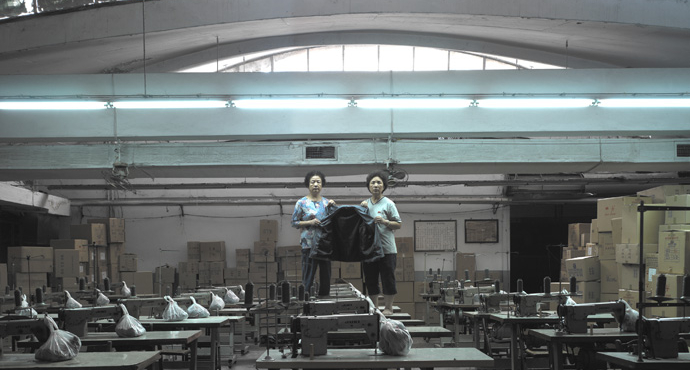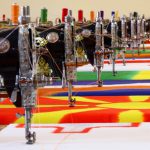- Artists
Overview
In 2003 Taiwanese artist Chen Chieh-jen invited workers to return to the Lien Fu garment factory which had been closed down 7 years earlier. His emotive film is set within the context of manufacturing moving abroad in search of cheaper labour and unscrupulous owners refusing to pay retirement pensions and severance.
Silently Chen Chieh-jen explores the ‘transplantation’ of production and the ‘untransplanted’ – the workers who have no choice but must linger on, unable to move. The women textile workers move around the derelict building surrounded by abandoned objects. Shots of bodily gestures are mixed with fragmentary images of their protests at the time of closure, as well as government produced footage of the 1960s when Taiwan’s manufacturing industry was booming.
Chen Chieh-jen has been nominated to receive the Artes Mundi Prize 2009.
Artist’s statement from Chen Chieh-jen
Factory (2003)
Due to Cold War relations and low-cost manpower, Taiwan became one of the major manufacturing centres of the world in the 1960s. Yet in the 1990s, Taiwan’s intensive manufacturing industry began to move abroad to other areas with cheaper labour. For this reason, factories in Taiwan began to close down, and to lay off large numbers of workers.
In 2003 I invited some women textile workers, whom I had accidentally met to return to the Lien Fu garment factory where they had worked for over two decades and which had been abandoned for seven years, to make this short film. Seven years before, company owners closed the plant in an unscrupulous manner, refusing to pay retirement pensions and severance payments. Although a fierce protest movement erupted at the time, to this day the problem remains unresolved, and the factory continues in its derelict state.
In places all over the world, many labourers have had similar experiences – a production relationship between the “transplanted” and the “untransplanted.” In order to find low-priced labour, factories constantly shift locations. But after being abandoned, unemployed workers have no choice but to linger on in the same place.
In this derelict garment plant, many abandoned objects still remained from seven years before: calendars, newspapers, punch clocks, worktables, chairs, manufacturing equipment, electric fans, the dust that had built up over seven years’ time, the stagnant, foul air, as well as the megaphones, loudspeakers and banners left behind from the workers’ protest. Over seven years, these objects had come to possess an inherent temporal meaningfulness. Therefore, I only rented some sewing machines, of the same make as the ones that had originally been used there and had been sold, and a vehicle similar to the one that the workers had used in their protests. As much as possible, I only used original objects that had been left behind in the factory. Over the course of seven years, these abandoned objects had acquired a dual feeling – of time having stopped and time flowing – and this “dual sense of time” became the foundation for the film’s narrative structure.
Because the women workers wished to remain silent when they were being filmed, when we formally started shooting, I first asked them to go back to the factory and “work.” They quickly fell into a state of concentrated labour. Returning to “work” after a separation of seven years, interacting with the sewing machines, cloth, and even the teacups on the table that had been part of their lives for twenty years, they seemed to effuse a certain ineffable spirit.
The film featured the women labourers returning to the factory to “work,” and also their bodily gestures and fragmentary images from the time of their protests. The camera concentrated on the women workers, “scanning” their extremely simple movements. I intermixed these simple images with documentary footage produced by the government back in the 1960s, when Taiwan’s manufacturing industry was in its infancy, in a mutually contrasting evolution. At the same time, responding to the women’s wishes not to speak, I chose to remove all the sound from the film.
The film is Super 16mm transferred to DVD, colour, silent, single-channel, continuous loop of 31 minutes, 09 seconds.
(Translation: Brent Heinrich)

